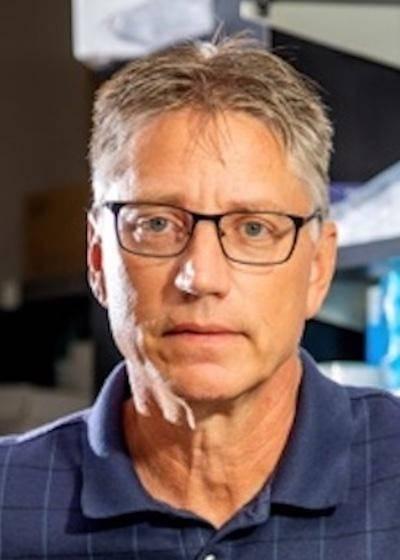|
Additional Contact Information:
|
Bio
I was born in central Nebraska, not far from the mile-wide, inch-deep Platte river
and grew up surrounded by seemingly endless cornfields that were long ago converted
from magnificent prairie grasslands. The small farming community where I grew up had
no stop lights, six churches, six taverns (7 if you count the VFW) and a six-lane
bowling alley that was open Thursday-Saturday. It wasn’t the middle of nowhere, but
I could throw a rock and hit it, so, I was highly motivated to attend college and
in 1987, I earned a B.S. in Biology from Peru State College (go Bobcats!). I have
only a few regrets from these formative years, but include eating a suspect rotisserie
hot dog from an unmemorable convenience store downwind from the Schuyler beef packing
facility in the summer of 1986.

Not knowing exactly what to do with a B.S. in Biology, I took the advice of a professor and applied to graduate programs with the aim of a career in research. Despite being accepted to graduate programs in the Midwest, the lure of a $7,500/yr graduate stipend and mild winters in an exotic southern location led me to the University of Tennessee-Knoxville (go Vols!) where I completed a PhD in Biochemistry in the 1993. It was there I met the love of my life, Cassandra, who was hoodwinked into thinking I was a charming individual with decorum. After completing a post-doctoral fellowship in Biochemistry and Genetics at the University of Colorado School of Medicine in Denver, I joined the Biochemistry Department at East Tennessee State University (ETSU) and the Quillen College of Medicine (QCOM) as a Research Assistant Professor in 1997. I am currently a full professor in the Department of Medical Education (DME) and the Department of Biomedical Sciences (DBMS) at QCOM.
My primary responsibilities are in the development, organization and delivery of content in QCOM basic science courses as well as the Biomedical Sciences graduate program. Within the QCOM TRAILS curriculum, I participate in the Foundations of Medical Knowledge (FMK) course using active learning pedagogy to dispense aliquots of medical knowledge on enthralling topics ranging from nucleotide metabolism to cell signaling. My other main function in the TRAILS curriculum is to serve as course director for the Cardiovascular, Pulmonary, and Renal (CPR) course; a 100% non-GMO, artisanal, organ system-based course that was handcrafted from only select, locally-sourced organic, hypoallergenic QCOM faculty. CPR melds a flipped-class room approach with active learning modalities to develop an integrative understanding of these organ systems and to further explore the relationship between the universality of myth and midlife subcultures. With influences as diverse as Machiavelli and John Lennon, CPR challenges both the traditional and theoretical limits of understanding and meaning so that vision becomes debased into a dialectic of futility. Temporal derivatives are reconfigured through emergent and repetitive practice and the student is left with clues to the essential unreality of the human condition. In addition to medical and graduate education, my research laboratory focuses on elucidating the cellular and molecular mechanisms underlying the development of atherosclerosis, and has been supported by extramural funding from the American Heart Association and the NIH National Heart, Lung, and Blood Institute.
Outside of QCOM, I enjoy hiking, biking, gardening, homebrewing, and spending time with family and friends. I have a fondness of spaghetti Westerns only surpassed by a love of big fluffy dogs, street vendor tacos, craft beer, college football and alt-country music. I despise overly-sauced sloppy BBQ, cigarette butts in my driveway, modern country music, loud-mouth know-it-alls, reality TV shows, almost anything to do with social media, and people that take themselves (and autobiographies) too seriously. I believe Junior Brown and Ray Wylie Hubbard are underrecognized national treasures, John Prine’s face should be added to Mount Rushmore, and no band was cooler than the Mojo Filter Kings. My favorite weekends are spent with my wife taking our grandchildren to ball games, catching trophy-sized bluegill at secret fishing spots, teaching them how to play the ponies at off-track betting sites, exploring the Appalachian countryside in search of breweries that allow children, or simply having a quiet evening at home discussing the finer points of Dirty Harry films over a pizza. Hopefully, they will be inspired to follow their passions and strive to be good people in that roundabout way Johnny Cash would write a song about.
EDUCATION/PROFESSIONAL EXPERIENCE
1987-1993: Ph.D., Biochemistry University of Tennessee Department of Biochemistry Knoxville, TN 37996-08401983-1987: B.S., Biology Peru State College Peru, NE 68421-0010
RESEARCH/CURRENT RESEARCH
1. Cellular and molecular mechanisms regulating atherosclerosis.
2. Cannabinoid receptor signaling in disease.
3. Cell signaling
Current Research Interest: Our current research focuses on understanding the pathophysiological role of oxidized LDL/oxysterol-induced apoptosis in atherosclerosis. Atherosclerosis is a chronic inflammatory disease of the vascular wall during which macrophages in the vascular intima ingest atherogenic lipoproteins, such as modified low density lipoproteins (LDL), and transform into cholesteryl ester-laden foam cells. Apoptotic foam cells have been well documented within atherosclerotic lesions. Our prior work showed that macrophage apoptosis represses lesion formation in mice, indicating that, at least in early lesions, macrophage apoptosis is anti-atherogenic. In advanced lesions, there is strong evidence that apoptosis of macrophage-derived foam cells is a pro-atherogenic factor contributing to plaque instability and rupture. Thus, the mechanisms regulating macrophage apoptosis are significant to both the development of lesions and the progression towards events that may directly trigger the acute clinical manifestations of atherosclerosis. Currently we are examining the role of cannabinoid receptors in regulating macrophage apoptosis and in the development of atherosclerosis in hyperlipidemic mice. We are also investigating in the pharmacological manipulation of cannabinoid receptors as potential therapy for pancreatic cancer.
LABORATORY PERSONNEL
Makenzie Fulmer- graduate studentEmilee Englehaupt- undergraduate student, Honors College
Zachary Lahrs- undergraduate student
Mathew Holt- undergraduate student
Thomas Christian- undergraduate student
Ben Cearlock- medical student
Kaitlyn Hinshaw- medical student
Brett Farmer- medical student
Chase Mussard- undergraduate student, Honors College
ACTIVE RESEARCH FUNDING
Current Support:
R15HL113878-01A1 “Modulations of atherosclerosis by cannabinoid type 2 receptor”; National Heart, Lung, and Blood Institute; Douglas P Thewke, P.I.; Antonio Rusinol, Co-Investigator; Stacy Brown, Co-Investigator; project period 01/10/2013 to 12/31/2015
Prior Support:
R15 HL085137 “The Role of CB2 Receptors in oxLDL-Induced Apoptosis and Atherogenesis” National Heart, Lung, and Blood Institute; Douglas P Thewke, P.I.; project period 8/01/06-7/31/09
R01 DK58071 “Regulation of stearoyl-CoA desaturases by oleate” National Institute of Diabetes and Digestive and Kidney Diseases; Douglas P Thewke, P.I.; project period 8/01/01-7/31/05
Scientist Development Grant American Heart Association “Regulation of Transcription by Oleate” Douglas P Thewke, P.I.; project period 8/1/99-7/31/00
PUBMED
SELECTED PUBLICATIONS
1.
Optimized Extraction of 2-Arachidonyl Glycerol and Anandamide from Aortic Tissue and Plasma for Quantification by LC-MS/MS
Christopher Garst, Makenzie Fulmer, Doug Thewke and Stacy Brown
European Journal of Lipid Science and Technology
DOI: 10.1002/ejlt.201500115
2.
Netherland CD, Pickle TG, Bales A, Thewke DP.
Atherosclerosis. 2010 Nov;213(1):102-8. Epub 2010 Aug 19.
PMID: 20846652 [PubMed - indexed for MEDLINE]
3.
Rimonabant is a dual inhibitor of acyl CoA:cholesterol acyltransferases 1 and 2.
Netherland C, Thewke DP.
Biochem Biophys Res Commun. 2010 Aug 6;398(4):671-6. Epub 2010 Jul 6.
PMID: 20609360 [PubMed - indexed for MEDLINE] Free PMC Article
Free full textRelated citations
4.
Liu J, Netherland C, Pickle T, Sinensky MS, Thewke DP.
Arch Biochem Biophys. 2009 Jul 1;487(1):54-8. Epub 2009 May 21.
PMID: 19464253 [PubMed - indexed for MEDLINE] Free PMC Article
Free full textRelated citations
5.
AM-251 and SR144528 are acyl CoA:cholesterol acyltransferase inhibitors.
Thewke D, Freeman-Anderson N, Pickle T, Netherland C, Chilton C.
Biochem Biophys Res Commun. 2009 Apr 3;381(2):181-6. Epub 2009 Feb 11.
PMID: 19338772 [PubMed - indexed for MEDLINE] Free PMC Article
Free full textRelated citations
6.
Freeman-Anderson NE, Pickle TG, Netherland CD, Bales A, Buckley NE, Thewke DP.
J Lipid Res. 2008 Nov;49(11):2338-46. Epub 2008 Jul 9.
PMID: 18614816 [PubMed - indexed for MEDLINE] Free PMC Article
Free full textRelated citations
7.
Freeman NE, Rusinol AE, Linton M, Hachey DL, Fazio S, Sinensky MS, Thewke D.
J Lipid Res. 2005 Sep;46(9):1933-43. Epub 2005 Jul 1.
PMID: 15995174 [PubMed - indexed for MEDLINE] Free PMC Article
Free full textRelated citations
8.
Liu J, Thewke DP, Su YR, Linton MF, Fazio S, Sinensky MS.
Arterioscler Thromb Vasc Biol. 2005 Jan;25(1):174-9. Epub 2004 Oct 21.
PMID: 15499039 [PubMed - indexed for MEDLINE] Free PMC Article
 Event Parking/Traffic Advisory
Event Parking/Traffic Advisory 